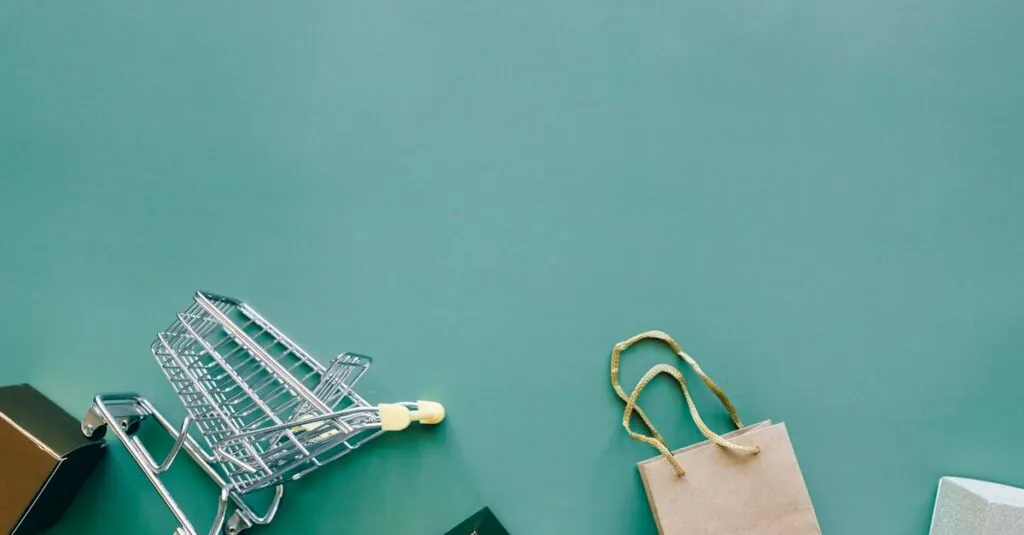Table of Contents
ToggleIn the fast-paced world of retail, product packaging isn’t just about keeping items safe; it’s the first impression that can make or break a sale. With consumers becoming more discerning, brands are stepping up their packaging game like never before. Gone are the days of bland boxes and forgettable labels; today’s packaging is a vibrant blend of creativity and sustainability that grabs attention and tells a story.
Overview of Product Packaging Trends
Product packaging trends reflect the changing needs and desires of consumers in the retail landscape. Sustainability stands out as a primary focus for brands. Eco-friendly materials such as biodegradable plastics and recycled paper gain traction, with many companies pledging to reduce their carbon footprints.
Creativity in design plays a significant role as well. Vibrant colors, unique shapes, and minimalist aesthetics attract consumers. Eye-catching graphics create memorable experiences, transforming packaging into a key marketing tool.
Customization has emerged as another trend. Brands personalize packaging to foster customer connection and enhance brand loyalty. Personalized touches like names or messages elevate the unboxing experience.
Functional packaging resonates with consumers. Innovations such as resealable bags or easy-pour spouts improve usability while minimizing waste. Enhanced functionality appeals to a broader demographic, including busy individuals seeking convenience.
Digital integration also redefines packaging. QR codes and augmented reality features offer interactive consumer experiences. By bridging physical products with digital content, brands engage shoppers in new ways.
Brand storytelling finds its place in packaging trends too. Narratives on packaging communicate brand values and sustainability efforts. Consumers today prefer products that align with their beliefs, making storytelling a vital component.
Transparency remains crucial. Clear labeling that provides information about ingredients and sourcing builds trust with consumers. Brands that prioritize transparency often see increased customer loyalty.
These trends collectively demonstrate a shift toward more conscious consumerism, where packaging no longer just protects products but also communicates values and engages customers effectively.
Eco-Friendly Packaging Solutions
Eco-friendly packaging solutions have gained traction as sustainability becomes a consumer priority. Brands increasingly adopt innovative materials and designs that minimize environmental impact.
Biodegradable Materials
Biodegradable materials provide a sustainable alternative to traditional plastics. These materials break down naturally over time, reducing landfill waste. Companies often use plant-based options, such as cornstarch or mushroom packaging, to create eco-friendly products. Familiar brands like Coca-Cola are experimenting with biodegradable bottles to align with sustainability goals. Additional innovations include compostable films and paper products that decompose without leaving harmful residues. Consumers actively seek these options, reflecting a growing demand for responsible packaging solutions.
Recyclable Design
Recyclable design plays a crucial role in eco-friendly packaging. Packaging made from recyclable materials enables consumers to participate in waste reduction. This approach often incorporates easily separable elements, facilitating the recycling process. Brands like Unilever prioritize simplicity in their packaging designs to ensure higher recycling rates. Moreover, clear recycling instructions on packaging guide consumers in proper disposal methods. Research indicates that 67 percent of consumers consider recyclable packaging important when purchasing products. Emphasizing recyclable design enhances brand reputation and aligns with environmentally conscious consumer values.
Innovative Packaging Technologies
Innovative packaging technologies transform how brands engage with consumers. They enhance convenience and communication while aligning with sustainability goals.
Smart Packaging Features
Smart packaging features utilize sensors and digital technologies to create interactive experiences. Brands incorporate functionalities like freshness indicators and tamper-evident seals, ensuring product quality and safety. Many consumers appreciate the ability to scan QR codes for information about ingredients, usage, and ecological impact. Research indicates that 49 percent of shoppers prefer packaging that offers additional information. This integration enhances the overall purchasing experience, fostering a stronger connection between the product and the consumer.
Automation in Packaging
Automation in packaging streamlines processes through advanced machinery and robotics. Brands that adopt automated systems gain efficiencies in production speed and accuracy, which reduces labor costs. Over 53 percent of companies report increased efficiency by implementing these technologies. Additionally, sustainability improves, as automation minimizes material waste through precise sourcing and handling. Flexible automation allows brands to respond quickly to market changes, enabling customization and scalability without compromising quality.
Aesthetic and Branding Considerations
Product packaging now plays an integral role in shaping brand identity and consumer perception. The visual appeal and design choices directly influence how consumers connect with products.
Minimalist Design Trends
Minimalist design trends emphasize simplicity over complexity. Clean lines, muted color palettes, and ample white space attract attention while allowing the product to shine. Such designs often resonate with consumers seeking clarity and authenticity. Brands that adopt minimalist aesthetics frequently enhance brand recognition and improve shelf visibility. Research shows that 75 percent of consumers appreciate straightforward packaging, making it a powerful tool in consumer decision-making.
Customization and Personalization
Customization and personalization offer brands an opportunity to create deep connections with consumers. Unique packaging that reflects individual buyer preferences fosters loyalty and strengthens engagement. Brands can leverage data to tailor designs that cater to specific demographics. Such targeted approaches resonate well in an era where 60 percent of shoppers expect personalized experiences. Applying individualized messaging or limited-edition designs can significantly enhance perceived value and strengthen brand affinity.
Consumer Behavior Impact
Shoppers’ preferences significantly influence product packaging trends. Sustainability stands out, with 67 percent of consumers deeming recyclable packaging important during their purchasing decisions. Eco-friendly materials such as recycled paper and biodegradable plastics attract environmentally conscious buyers, encouraging brands to adopt these solutions. The impact of sustainable practices is evident as familiar brands like Coca-Cola experiment with biodegradable bottles, aligning their products with consumer values.
Creativity captures attention in a crowded marketplace. Unique shapes and vibrant colors draw consumers, while minimalist designs promote clarity. Research shows 75 percent of shoppers appreciate straightforward packaging, leading to enhanced brand recognition. Customization fosters closer connections. Personalizing packaging to meet individual preferences can boost customer loyalty, especially since 60 percent of consumers expect this tailored approach.
Functionality matters as well. Innovations like resealable bags and easy-pour spouts cater to busy lifestyles, improving usability. Incorporating digital elements also engages consumers, with QR codes offering interactive experiences that deepen brand connections. Effective brand storytelling on packaging communicates values and sustainability efforts, resonating with shoppers’ beliefs. Transparency in labeling strengthens trust; brands revealing clear information about ingredients often see heightened customer loyalty.
Innovative technologies transform consumer interactions. Smart packaging, featuring sensors and digital tools, integrates functionalities like freshness indicators. Almost half of shoppers—49 percent—prefer packaging that provides additional information, enhancing their purchasing experience. Automation in production avoids inefficiencies through advanced robotics, and more than 53 percent of companies report improved efficiency with these methods. Enhanced sustainability emerges from precise sourcing, reducing material waste. These trends demonstrate a commitment to conscious consumerism, where packaging serves not just a functional role, but also an engaging and value-driven experience.
Product packaging is no longer just a protective layer; it’s a vital element of brand identity and consumer engagement. As brands adapt to shifting consumer preferences, the focus on sustainability, creativity, and functionality becomes increasingly pronounced. Innovative materials and designs not only attract attention but also resonate with eco-conscious shoppers.
Customization and digital integration further enhance the shopping experience, creating meaningful connections between brands and consumers. As these trends continue to evolve, they reflect a broader movement towards conscious consumerism, where packaging serves as a powerful tool for communication and brand loyalty. Embracing these changes is essential for brands looking to thrive in a competitive marketplace.




